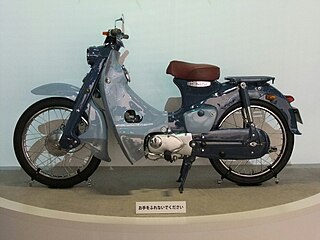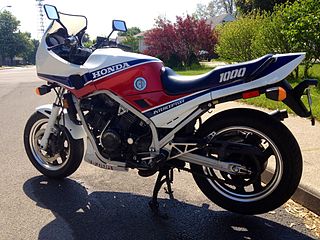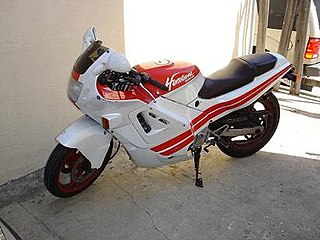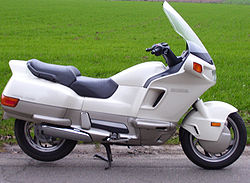
The Honda Hawk GT (NT650) motorcycle was designated as model RC31 and was designed by Toshiaki Kishi, and was the second Honda with "Pro-Arm" suspension bike after the RC30 VFR750R. The RC model designation is for bikes up to 750 cc, though the Honda Pacific Coast (PC800) has an engine of more than 750 cc and a model designation of RC34.
The Honda ST series, also known as the Pan-European in Europe, is a duo of Sport Touring motorcycles comprising the ST1100 and the later ST1300.

The Honda Valkyrie is a motorcycle that was manufactured by Honda from 1997 to 2003. It was designated GL1500C in the US market and F6C in other markets.

The Honda Gold Wing is a series of touring motorcycles manufactured by Honda. Gold Wings feature shaft drive and a flat engine. Characterized by press in September 1974 as "The world's biggest motor cycle manufacturer's first attack on the over-750cc capacity market...", it was introduced at the Cologne Motorcycle Show in October 1974.

A sport bike, sports motorcycle, or sports bike is a motorcycle designed and optimized for speed, acceleration, braking, and cornering on asphalt concrete race tracks and roads. They are mainly designed for performance at the expense of comfort, fuel economy, safety, noise reduction and storage in comparison with other motorcycles.

The Honda Super Cub is a Honda underbone motorcycle with a four-stroke single-cylinder engine ranging in displacement from 49 to 124 cc.

Maicowerk A.G., known by its trading name Maico is the name of a family company in the Swabian town of Pfäffingen near Tübingen. Founded in 1926 by Ulrich Maisch as Maisch & Co, the company originally manufactured 98 and 123 cc Ilo two-stroke engines. After World War II, they began producing their own unit construction two-stroke engines, selling complete motorcycles. Maico made a brief foray into the automobile business with their own line of microcars in the late 1950s. Maico have also made go kart engines.

The VF1000 is a range of motorcycles produced by Honda from 1984 to 1988. The VF1000 is named after its V-4 998 cc (60.9 cu in) double overhead cam 16-valve engine. There were three main models in the VF1000 range, the VF1000F, the VF1000R and the VF1000F2.

The Honda CBR600F is a CBR series 600 cubic centimetres inline four-cylinder sport bike motorcycle made by Honda Motorcycles. The first model of the CBR600F was sold from 1987 to 1990 and is known in the US as the Hurricane. In Austria and Mexico, a smaller version, called CBR500F, was offered. The subsequent models are designated as CBR600F2, F3, F4, and F4i respectively. In 2011, Honda released a more modern model with the same name.

The Honda VTX series is a line of V-twin Honda cruiser motorcycles inspired by the Zodia concept shown at the 1995 Tokyo Motor Show. The Honda VTX 1800 was launched in 2001 as a 2002 model. At the time this bike was introduced the Honda VTX engine was the largest displacement production V-twin in the world, but that distinction would be short-lived as the VTX1800 was superseded in 2004 by the 2.0-litre Kawasaki Vulcan 2000. Nevertheless, the VTX 1800 still produced better 0-60 mph and 1/4 mile times.

The Honda CBR1000RR, marketed in some countries as the "Fireblade", is a 999 cc (61.0 cu in) liquid-cooled inline four-cylinder superbike, introduced by Honda in 2004 as the 7th generation of the CBR series of motorcycles that began with the CBR900RR in 1992.
A dual-sport motorcycle is a type of street-legal motorcycle that is designed for both on and off-road use. The terms all-road, on/off-road, and dual-purpose are also used for this class of motorcycles. Dual-sports are equipped with street-legal equipment such as lights, speedometer, mirrors, horn, license plate mounting, and muffler and can, therefore, be registered and licensed.

The Honda ST-series minibikes are known as the Dax in Japan and Europe, and the Trail 70 in Canada and the US.
The Honda CT series was a group of Honda trail bike motorcycles made since 1964. The CT designation is a slight exception in Honda nomenclature in that "CT" does not indicate a series of mechanically related bikes, but rather a group of different bikes that are all for casual off-road use.

The Honda Deauville, also designated the NT650V and NT700V, is a mid-range touring motorcycle manufactured and marketed by Honda over a fifteen-year production run (1998–2013) spanning three generations — and named after the French seaside resort.
The Honda Elite is a series of scooters manufactured by Honda since 1983. Honda currently makes the 108 cc (6.6 cu in) 2010 Elite.

The Honda Fury was the first production chopper from a major motorcycle manufacturer (Honda). In a break with tradition, the Fury was the first chopper to have an anti-lock braking system The Fury's styling has been likened to custom-made choppers from Paul Teutul Sr. or Arlen Ness. The Fury has been sold not only in North America, but internationally as well, although in some markets Honda eschewed the Fury name and offered the bike simply by its model ID: VT1300CX.
Motorcycle accessories are features and accessories selected by a motorcycle owner to enhance safety, performance, or comfort, and may include anything from mobile electronics to sidecars and trailers. An accessory may be added at the factory by the original equipment manufacturer or purchased and installed by the owner post-sale as aftermarket goods. The term Farkle is used within the motorcycle community, originally to denote useful add-ons, such as GPS or other upgraded components. Now also used at times in a humorous or mildly derogatory way to describe bling, such as anodized or chromed parts that add no functionality.

A scooter is a motorcycle with an underbone or step-through frame, a seat, a transmission that shifts without the operator having to operate a clutch lever, a platform for the rider's feet, and with a method of operation that emphasizes comfort and fuel economy. Elements of scooter design were present in some of the earliest motorcycles, and motor scooters have been made since at least 1914. More recently, scooters have evolved to include scooters exceeding 250cc classified as Maxi-scooters.
The Honda CB900F is a Honda motorcycle made in two iterations which appeared some twenty years apart. Both generations of the CB900F are straight four-cylinder four-stroke 900 cc (55 cu in) roadsters.














